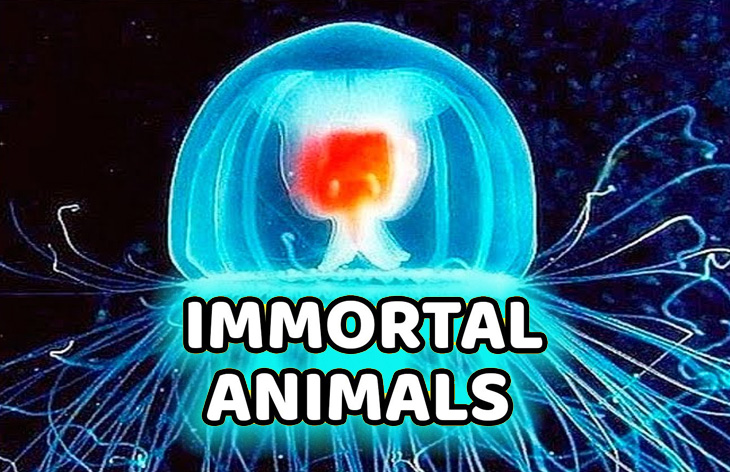There are many animal/creature we found in the earth that live longer than expectation. As per science research we human can live maximum of 150 years naturally, but due to pollution and extra element we score our life below 100 years. We also know that tortoise live longer life than expectation but very few of us know that some animal/creature lives like immortal, Surprisingly, all the longest living creatures live in water.. Let’s see the list—
 Bowhead Whale: Age: 200+ years
Bowhead Whale: Age: 200+ years
The Bowhead Whale is at the bottom of the ladder of longevity. It is found in arctic and sub-arctic seas. According to the National Oceanic and Atmospheric Administration (NOAA), they live comfortably for 100 years. But some live more than 200 years. They have a gene in their body, which is called ERCC1. This gene keeps on repairing the damaged DNA in the body.
 Rough eye Rockfish: Age 200+ years
Rough eye Rockfish: Age 200+ years
Rough eye Rockfish is one of the lengthiest years living fish. According to the Washington Department of Fish and Wildlife, it lives for at least 205 years. This pinkish-brown fish is found in the Pacific Ocean from California to Japan. It can be up to 38 inches long. It eats small fish and shrimps
 Freshwater Pearl Mussel: Age 250+ Years
Freshwater Pearl Mussel: Age 250+ Years
Freshwater Pearl Mussels are commonly found in rivers and streams. Mostly in Europe, America and Canada. According to the World Wildlife Fund (WWF), the oldest Freshwater Pearl Mussel is 280 years old. They live for so long because their digestion process is very slow.
 Greenland Shark: Age 272+ Years
Greenland Shark: Age 272+ Years
The Greenland Shark lives at great depths in the Arctic and North Atlantic Oceans. It can grow up to 24 feet long. It makes its food for many types of sea creatures. According to a study published in the year 2016 in the journal Science, their average age is 272 years. Whereas the longest living Greenland shark is 392 years old. Although some researchers believe that they can live up to 512 years. There is a lot of debate about its maximum age, but its average age is 272 years, all scientists agree.
 Tubeworm: Age 300+ Years
Tubeworm: Age 300+ Years
Tubeworms live in very cold areas in the deep sea. According to a report published in The Science of Nature in the year 2017, a species of tubeworm was found in the Gulf of Mexico that lived for 200 years. While there are some species that live more than 300 years. Tubeworms are less prone to death. Because they have no natural enemies or predators.
 Ocean Quahog Clam: Age 500+ years
Ocean Quahog Clam: Age 500+ years
The Ocean Quahog Clam is found in the North Atlantic Ocean. This creature found in salty water lives for more years than other species like itself. According to the National Museum of Wales, in 2006, an ocean quahog clam was found off the coast of Iceland, which was 507 years old. This ancient clam was named Ming. It was born in 1499.
 Black Coral: Age 4000+ Years
Black Coral: Age 4000+ Years
Corals are often very colorful and beautiful looking sea creatures. They are like a kind of exoskeleton. They keep making genetic copies like themselves. When multiple polyps combine to form a single genetic sequence, they form a coral. Generally, corals live for hundreds of years, but black corals found in very deep depths are said to be the longest living corals. A black coral was found off the coast of Hawaii, whose age was said to be 4265 years.
 Glass Sponge: Age more than 10 thousand years
Glass Sponge: Age more than 10 thousand years
Glass sponges are usually a colony of several organisms. Like corals are. They can live for thousands of years. They are one of the largest living sponges on earth. According to NOAA, they live at great depths in the sea and also at low depths. According to a report published in the Journal of Chemical Geology in 2012, the oldest glass sponge is 11,000 years old. There may also be sponges that live longer than this.
 Turritopsis dohrnii: Possibly immortal…
Turritopsis dohrnii: Possibly immortal…
Turritopsis dohrnii is called the immortal jellyfish. It starts life like a larva. After this, they take their own hinges in the sea floor. Polyps begin to form. These polyps then release the medusas or jellyfish, so that they can start swimming in the ocean. According to the American Museum of Natural History, the adult Turritopsis dohrni has the potential to revert to polyps. If he gets any damage. Or if food is not available, then it comes back in the category of polyps. When needed, it turns back into a jellyfish. It is commonly found in the Mediterranean Sea. It can repeat its life cycle many times. Its size is 4.5 millimeters.
 Hydra: Possibly Immortal…
Hydra: Possibly Immortal…
Hydra are very small invertebrates. Their body is very soft. Sometimes they look like jellyfish. Hydra are also probably immortal. Because scientists have not been able to guess their age correctly till date. They do not show physical illness or damage with their increasing age. They are usually made of stem cells. Those who are constantly reborn on their own. Or just say that keep cloning. If they do not fall prey and do not get diseases, then they can become immortal.

![Buddha Purnima 2025 [TKB INDIA]](https://topknowledgebox.com/iphaphoo/2025/05/12052025-150x150.jpg)
![YouTube is about to turn 20, the company announced many big features [TKB Tech]](https://topknowledgebox.com/iphaphoo/2025/04/28042025-150x150.jpg)
![Basant Panchami 2025: Know the correct date and auspicious time [TKB INDIA]](https://topknowledgebox.com/iphaphoo/2025/01/31012025-150x150.jpg)

![Amazing feature of WhatsApp, you will be able to reply without listening to the voice message[TKB Tech]](https://topknowledgebox.com/iphaphoo/2024/11/24112024-150x150.jpg)







Love the information, I wish I was immortal girl- ‘always young’
Thanks for support,stay in touch for more information.
Very interesting article. Would love to read more such topics.
Thank you for your support, we try to come up with new article everyday, so stay connected